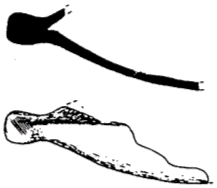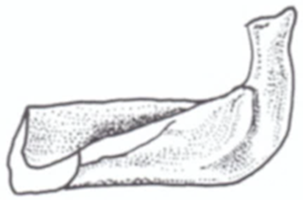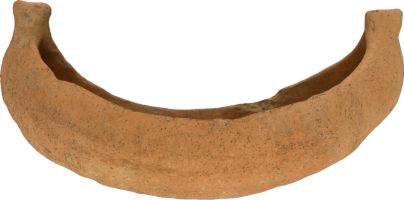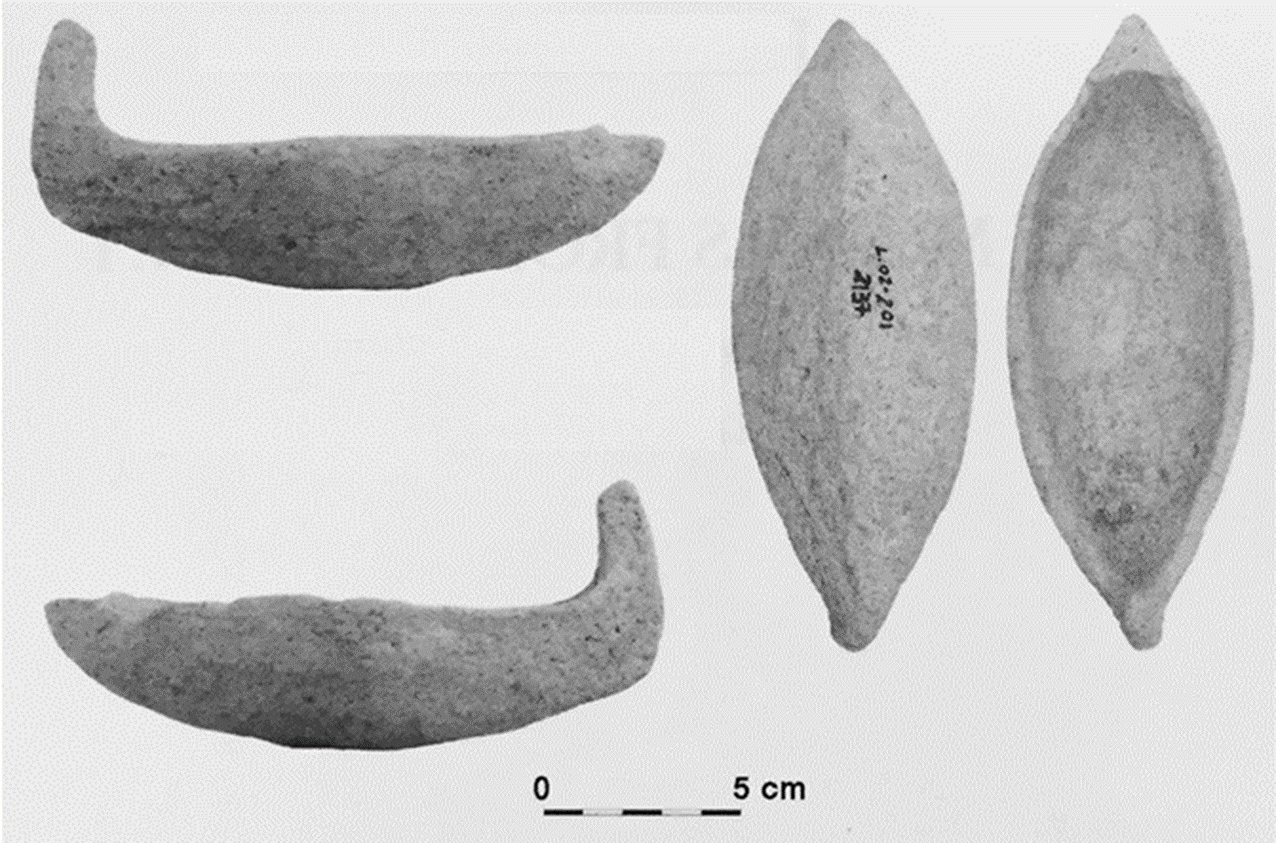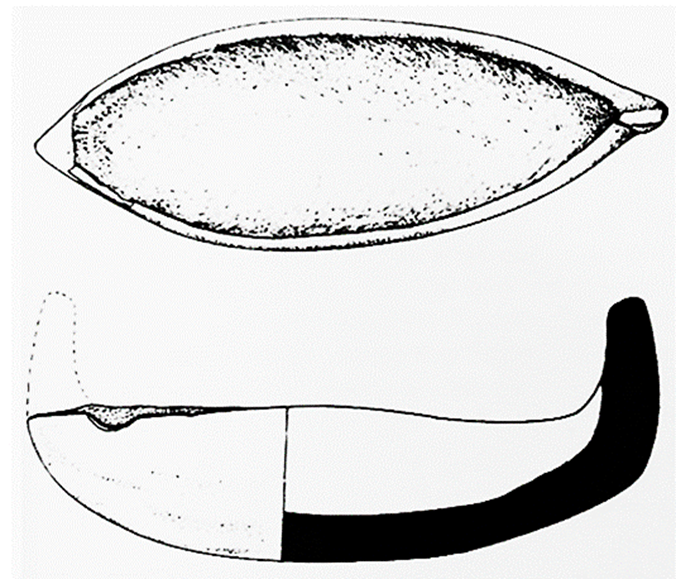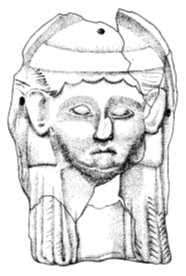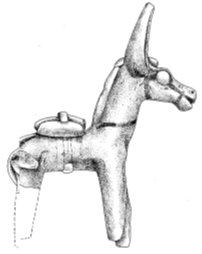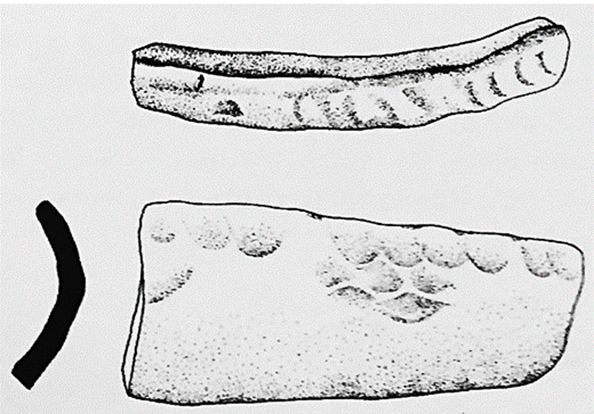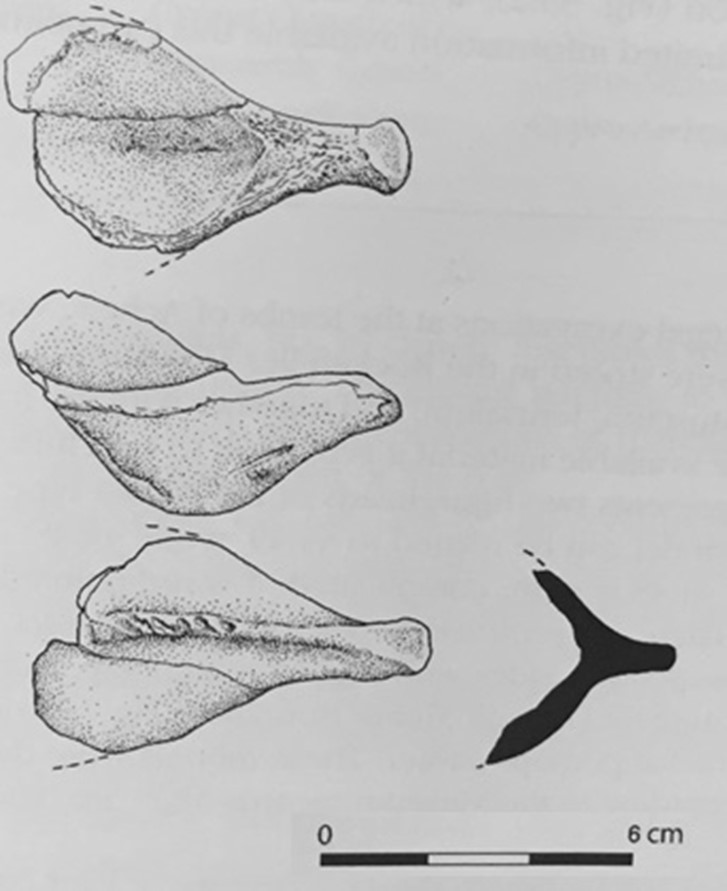L35 (Boat model L. 02-201; B.2137): Complete boat model discovered
near the center of the southern wall of the tomb along with other burial
gifts that include two round-bodied mushroom jugs dated to the 8th
century B.C. One of the posts is broken at gunwale level.
Crescenting/rockered hull with vertical, symmetrical posts. The
preserved post curves upward at a fairly sharp angle, then gains a
slight inward inclination above gunwale level. It has a flat undecorated
extremity (1.2-1.5 cm wide, 1cm thick), its end worn away. The gunwale
is flat and horizontal. On the outside of the hull can be discerned
three longitudinal lines which could be read as keel, chine and wale. It
is more likely however that these are the result of crude workmanship
rather than actual features, considering that they occur on only one
half of the hull while the other side is smooth. Likewise, the lowermost
line running along the boat's length which could be read as the keel is
not centered. The inside of the hull is smooth, with no indication of
frames, thwarts or other internal features. The cross section is open
without tumblehome. The breadth to length ratio is roughly 1:2.6 which
suggests a round vessel.
L36 (Boat model fragment L.2029; B.8725): Handmade clay fragment of
one end of a boat model: "It represents a concave end of a boat, as a
result of pinching for creating the endpost and a protruding cutwater.
The post projects upwards and is 1.6 cm wide and 1.2 cm thick. The
thickness of the sides is about 5 mm. Its upper edge is broken." (Kahanov 2004: 167.)
L37 (Boat model fragment L.2029; B.9247): Fragment of an edge of a
boat model showing the post and cutwater that were made by pinching the
clay. The post is broken at its uppermost end. It is 1.2-1.6 mm wide and
0.9-1.1 cm thick.
L38 (Boat model fragment L.02-201; B.2736): Handmade clay fragment.
One of the edges is worked smooth while the other is broken. Vertical
post with a flat, undecorated top. The external edge of the post is
hollow/ slightly concave.
One complete and three fragmentary boat models
L35-L38
8th century B.C. (Tomb phase 3, end of 9th- late 7th century B.C.)
Tomb no 1, Achziv northern cemetery
L35 L: 15.2 cm; W: 5.9 cm; H: 6.4 cm; (side) H: 3.5 cm; thickness: 4-7 mm
L36 L: 3.5 cm; W: 2.6 cm; H: 5 cm
L37 L: 3.1 cm; W: 2.5 cm; H: 5.9 cm
L38 L: 9.6 cm; W: 3.9 cm; H: 1.5 cm
Terracotta boat models. Light brown clay.
Kahanov 2004: 167-73, photo 124, fig. 33; Mazar 2004: 38, photo 30
Achziv tomb no 1 is an exceptional ashlar built chamber tomb that saw continuous use from the 10th to the mid-6th century B.C., divided into four recognizable stratigraphical phases. All four boat models belong to phase 3 (end of 9th-7th century B.C.). This layer included accumulated burials and burial gifts over several generations of continuous use, with older material piled up at the back of the tomb and its eastern corners with the arrival of new occupants. Burial gifts include large amounts of pottery, numerous scarabs, faience amulets, jewellery (silver pendants, gold/silver/bronze earrings, bronze/silver rings, bronze bracelets, bronze fibulae, bone pin), and a few iron arrowheads. In addition to the four terracotta boat models, there was a terracotta female facemask, and figurines of a horseman, a baboon, a donkey, and another horse or donkey. Associated with phase 3 were also some Cypriot imports, including a Cypriot krater (no. 9222) and a BoR jug (no. 9322).
Kahanov, Y. 2004. “Boat Models from Tomb N.1,” in E. Mazar The Phoenician Family Tomb n.1 at the Northern Cemetery of Achziv (10th-6th Centuries BCE). Sam Turner Expedition: Final Report of the Excavations. Cuadernos de Arqueologia Mediterranea 10. Barcelona: Carrera Edició, Publicaciones del Laboratorio de Arqueología, Universidad Pompeu Fabra de Barcelona, pp. 167-173.
Mazar, E. 2004. The Phoenician Family Tomb n.1 at the Northern Cemetery of Achziv (10th-6th Centuries BCE). Sam Turner Expedition: Final Report of the Excavations. Cuadernos de Arqueologia Mediterranea 10. Barcelona: Carrera Edició, Publicaciones del Laboratorio de Arqueología, Universidad Pompeu Fabra de Barcelona.


